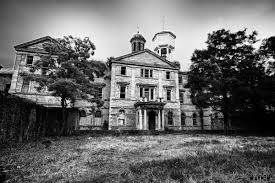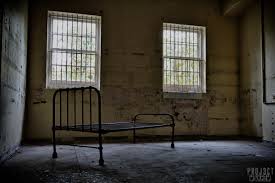 I’ve spent some time researching lunatic asylums, so I thought I’d post some of my findings here in a series. Please note I’m using the language of the time (‘lunatics’, etc)!
I’ve spent some time researching lunatic asylums, so I thought I’d post some of my findings here in a series. Please note I’m using the language of the time (‘lunatics’, etc)!
The modern view of the nineteenth- and early-twentieth century lunatic asylum is coloured by dramatic stories of wrongful incarceration and Gothic buildings in which unspeakable things happened. Sensation novels such as Sheridan le Fanu, The Rose and the Key (1871), Rosina Bulwer Lytton, A Blighted Life (1880) and Bram Stoker, Dracula (1897) fed the public’s fearful interest in asylums and the legacy of the fiction is still with us. Yet as Sarah Rutherford writes in The Victorian Asylum, Victorian asylums were ‘constructed as benevolent and compassionate facilities for vulnerable people’, with a community feel.
We know relatively little about how the mentally ill were treated before the seventeenth century, but we do know that they were often treated as a kind of entertainment, paraded in the streets. ‘Bedlam’, the Bethlem Hospital in London, was visited by people as a kind of freak show. But by the middle of the eighteenth century, attitudes were changing and much of the treatment was becoming more humane. By the nineteenth century there had been a considerable cultural shift in approaches towards the insane, and there was a huge growth of lunatic asylums throughout Britain. Some of these were run by charlatans, looking to make a profit from the unfortunates committed to their care, but many were designed to be run as a home-from-home, where patients were encouraged to enjoy country house-style surroundings and were often given freedoms or responsibilities in return for improvements in behaviour.
The nineteenth century saw the greatest changes in the treatment of the mentally ill so far. The subject was a controversial and  frequently discussed one: periodicals and newspapers often included articles on the subject of psychology, as well as the treatment of the insane, and there was a lot of public concern about maltreatment of vulnerable individuals, and abuses of the system. There were, of course, many who were also concerned about public safety, and the security of the asylums. There was little provision for treatment outside an asylum; more often than not, those more minor (or less dangerous) cases would be kept at home and receive little or no treatment.
frequently discussed one: periodicals and newspapers often included articles on the subject of psychology, as well as the treatment of the insane, and there was a lot of public concern about maltreatment of vulnerable individuals, and abuses of the system. There were, of course, many who were also concerned about public safety, and the security of the asylums. There was little provision for treatment outside an asylum; more often than not, those more minor (or less dangerous) cases would be kept at home and receive little or no treatment.
The subject of the asylums was often debated in Parliament, causing a number of bills and reform acts to be passed during the nineteenth century. Lord Shaftesbury, particularly active as the Chairman of the Lunacy Commission in the mid-nineteenth century, worked towards a more humane and effective system for caring for the mentally ill, culminating in the Lunatics Act of 1845. This instituted a system of licensing, inspection and reporting designed to protect inmates of asylums, and it set in train a move towards a greater emphasis on curing patients as well as taking their happiness and general health into account.
Further reforms took place during the nineteenth century, attempting to ensure that the asylum system was not abused and that  patient protection was in place. The system was not, of course, fool-proof: abuses continued to take place, from unkindness or carelessness, or lack of money (or parsimony) on the part of the asylum owners. Doctors were not above being bribed to take a sane patient whose family wished them out of the way for some reason, and ‘treatment’ could still be violent and unpleasant, causing the asylum to become more of a prison than a home-from-home. The system incorporated both private and public asylums, the latter taking paupers or those who could not afford to pay, and generally speaking the difference between the two was as great as one might expect.
patient protection was in place. The system was not, of course, fool-proof: abuses continued to take place, from unkindness or carelessness, or lack of money (or parsimony) on the part of the asylum owners. Doctors were not above being bribed to take a sane patient whose family wished them out of the way for some reason, and ‘treatment’ could still be violent and unpleasant, causing the asylum to become more of a prison than a home-from-home. The system incorporated both private and public asylums, the latter taking paupers or those who could not afford to pay, and generally speaking the difference between the two was as great as one might expect.
Despite these attempts to make the system safer, and to ensure the wellbeing of the patients as well as the safety of the public, popular perception of the nineteenth and early twentieth century lunatic asylum is of a place of terror, Gothic, dark and filled with unknown horrors. Much of this is due to the reports of patients incarcerated against their will, often for financial reasons by their relatives. There was, of course, ongoing abuse of the system, in which patients might be horrifically badly treated; and the situation was exacerbated by the buildings themselves, often dark, forbidding places which permitted the imagination to run wild. Such fears were shored up by speculation in the press, and also by sensation novels, which often portrayed women incarcerated in fearful asylums against their will.
Leave a comment